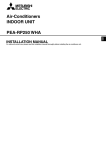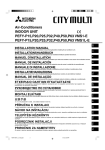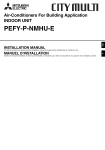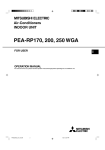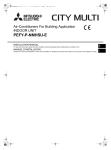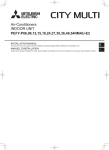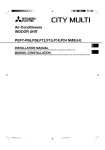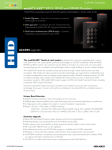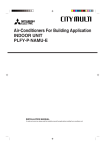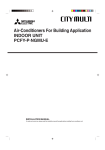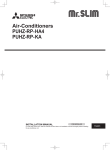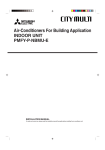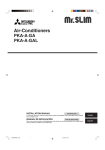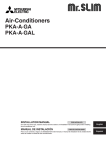Download Mitsubishi PEA-RPWHA Installation manual
Transcript
Air-Conditioners INDOOR UNIT GB PEA-RP170,200 WHA INSTALLATION MANUAL For safe and correct use, please read this installation manual thoroughly before installing the air-conditioner unit. 3 3.2 [Fig. 3.2.1] 800 1100 200~300 150~200 C B 1350 1034 450 A 1100 37 23 more than 20 1250 1324 23 E 30 ±10 470 more than 100 more than 20 D 50 60 50 730 Keep the service space for the maintenance from the bottom when the heat exchanger is cleaned. A 4 A Access door B Electrical parts box C Air inlet D Air outlet E Ceiling surface A Center of gravity 4.1 [Fig. 4.1.1] 1324 235 1034 494 701 A 5 5.1 [Fig. 5.1.1] 5.3 C [Fig. 5.1.2] [Fig. 5.3.1] A D A D C B E C Nuts (field supply) A Unit body D Washers (accessory) B Lifting machine E M10 hanging bolt (field supply) 6 A Indoor unit’s bottom surface 6.2 [Fig. 6.2.1] D B 100 244 52 C 30 165 A E 2 424 F A Air inlet B Refrigerant piping (liquid) C Refrigerant piping (gas) D Control box E Drain pipe F Air outlet 7 7.1 [Fig. 7.1.1] [Fig. 7.1.2] A A A Cut here B Remove brazed cap Cool by a wet cloth [Fig. 7.1.3] A A Thermal insulation tubing (small) B Caution: Pull out the thermal insulation on the refrigerant piping at the site, braze the piping, and replace the insulation in its original position. B C Take care to ensure that condensation does not form on exposed copper piping. E D M N G P O C Refrigerant piping (liquid) D Refrigerant piping (gas) E Main body F Thermal insulation tubing (large) G Site refrigerant piping H Ensure that there are no gaps between the insulation and the main body. I Thermal insulation tubing (small) (supplied) 1 J Ties (large) (supplied) 4 K Ensure that there is no gap here. Place join upwards. L Thermal insulation tubing (medium) (supplied) 2 M Thermal insulation N Pull O Flared pipe end P Wrap with damp cloth Q Return to original position R Ensure that there is no gap here. F M I H J K 20 E Q 20 R L K 20 J 20 7.2 [Fig. 7.2.1] C C C B Drain hose (Accessory) E A B A Downward slope 1/100 or more C Indoor unit 1 D Collective piping D 2 E Maximize this length to approx. 10 cm [Fig. 7.2.2] I B A G F 5 25 D E H C A Indoor unit B Insulation pipe (short) (accessory) C Tie band (accessory) D Band fixing part E Insertion margin F Drain hose (accessory) G Drain pipe (O.D. ø32 PVC TUBE, field supply) H Insulating material (field supply) I Max.145 ± 5 mm 3 8 [Fig. 8.0.1] D D C C B I A 9 E H F G A Air inlet B Air filter (supplied at site) C Duct D Canvas duct E Access door F Ceiling G Ensure sufficient length to prevent short cycling H Air outlet I Keep duct-work length 850 mm or more 9.1 9.2 [Fig. 9.1.1] [Fig. 9.2.1] B A S1 S2 S3 S1 S2 S3 1 2 TB4 A TB15 B A Terminal block for indoor transmission cable B Terminal block for outdoor transmission cable C Remote controller C [Fig. 9.2.2] B C 2 A Switch 16 A B Overcurrent protection 16 A C Indoor unit D A 1 S3 S2 S1 DC10~13V L C N A B 1 2 A Non-polarized B TB15 C Remote Controller D TB4 9.3 [Fig. 9.3.1] [Fig. 9.3.2] B B A 4 C A Screw holding cover (2pcs) B Cover A A Terminal bed box B Knockout hole C Remove [Fig. 9.3.3] E I L F N L N G K 1 M J S1 S2 S3 L 2 H S1 S2 S3 O N E Use PG bushing to keep the weight of the cable and external force from being applied to the power supply terminal connector. Use a cable tie to secure the cable. Wind the wire around the cable strap once to keep it from being pulled out. F Power source wiring G Tensile force H Use ordinary bushing I Power source terminal bed J Terminal bed for indoor transmission K Terminal bed for remote controller L To 1-phase power source M Transmission line N Terminal bed for outdoor transmission line O Transmission line to the remote controller [Fig. 9.3.4] S1 S2 A S3 B C A Terminal bed B Round terminal C Transmission cable (polar) 9.4 [Fig. 9.4.1] 1 Mode number ⁄ 2 2 Setting number ⁄ 3 4 3 Refrigerant address ⁄ 4 4 Unit number ⁄ 1 TEMP. F E G MENU BACK PAR-21MAA MONITOR/SET ON/OFF ON/OFF 1 A FILTER DAY CLOCK 2 Filter B TEST button C Set Time button D Timer On/Off button (Set Day button) E Mode selection button F Set temperature button G Timer Menu button (Monitor/Set button) CHECK TEST OPERATION B CLEAR 1 C A D [Fig. 9.4.2] F E C button (<Enter> button) [Fig. 9.4.3] D B B ED TEST RUN COOL, HEAT ˚C ˚C ˚C SIMPLE ˚C SIMPLE TEMP. MENU ON/OFF ON/OFF A FILTER TEMP. C MENU BACK MONITOR/SET DAY CLOCK OPERATION A ON/OFF button B Test run display MONITOR/SET FILTER DAY CHECK TEST CLEAR PAR-21MAA HG ON/OFF CHECK TEST BACK PAR-21MAA ON/OFF CLOCK OPERATION I M F Error code display Test run remaining time display CLEAR A A CHECK button B Refrigerant address C Indoor temperature liquid line temperature display G Set temperature button C TEMP. button H Mode selection button D D ON/OFF lamp I Fan speed button IC: Indoor unit OC: Outdoor unit E Power display M TEST button E Check code 5 GB Contents 1. Safety precautions ...................................................................................... 1.1. Before installation and electric work .......................................... 1.2. Precautions for devices that use R410A refrigerant .................. 1.3. Before getting installed .............................................................. 1.4. Before getting installed (moved) - electrical work ...................... 1.5. Before starting the test run ........................................................ 2. Indoor unit accessories ............................................................................... 3. Selecting an installation site ....................................................................... 3.1. Install the indoor unit on a ceiling strong enough to sustain its weight .................................................................................... 3.2. Securing installation and service space .................................... 3.3. Combining indoor units with outdoor units ................................. 4. Fixing hanging bolts .................................................................................... 4.1 Fixing hanging bolts ................................................................... 5. Installing the unit ......................................................................................... 5.1. Hanging the unit body ................................................................ 5.2. Transporting the heat exchanger unit and the fan unit separately .................................................................................. 6 6 6 7 7 7 7 7 8 8 8 8 8 8 8 8 5.3. Confirming the unit’s position and fixing hanging bolts .............. 8 6. Refrigerant pipe and drain pipe specifications ............................................ 8 6.1. Refrigerant pipe and drain pipe specifications ........................... 9 6.2. Refrigerant pipe, drain pipe ....................................................... 9 7. Connecting refrigerant pipes and drain pipes ............................................. 9 7.1. Refrigerant piping work .............................................................. 9 7.2. Drain piping work ....................................................................... 9 8. Duct work .................................................................................................. 10 9. Electrical wiring ......................................................................................... 10 9.1. Power supply wiring ................................................................. 10 9.2. Connecting remote controller, indoor and outdoor transmission cables ................................................................. 10 9.3. Connecting electrical connections ........................................... 11 9.4. Function settings (Function selection via the remote controller) .......................... 11 9.5. Before test run ......................................................................... 12 9.6. Test run .................................................................................... 12 9.7. Self-check ................................................................................ 12 1. Safety precautions 1.1. Before installation and electric work D s Before installing the unit, make sure you read all the “Safety precautions”. • • F s The “Safety precautions” provide very important points regarding safety. Make sure you follow them. Symbols used in the text E Warning: Describes precautions that should be observed to prevent danger of injury or death to the user. • • • I Caution: Describes precautions that should be observed to prevent damage to the unit. Symbols used in the illustrations • NL : Indicates an action that must be avoided. : Indicates that important instructions must be followed. : Indicates a part which must be grounded. P : Indicates that caution should be taken with rotating parts. (This symbol is displayed on the main unit label.) <Color: Yellow> GR : Beware of electric shock (This symbol is displayed on the main unit label.) <Color: Yellow> • • Warning: Carefully read the labels affixed to the main unit. RU • Warning: TR • • • SV • HG • • PO CZ • • • Ask the dealer or an authorized technician to install the air conditioner. - Improper installation by the user may result in water leakage, electric shock, or fire. Install the air unit at a place that can withstand its weight. - Inadequate strength may cause the unit to fall down, resulting in injuries. Use the specified cables for wiring. Make the connections securely so that the outside force of the cable is not applied to the terminals. - Inadequate connection and fastening may generate heat and cause a fire. Prepare for typhoons and other strong winds and earthquakes and install the unit at the specified place. - Improper installation may cause the unit to topple and result in injury. Always use an air cleaner, humidifier, electric heater, and other accessories specified by Mitsubishi Electric. - Ask an authorized technician to install the accessories. Improper installation by the user may result in water leakage, electric shock, or fire. Never repair the unit. If the air conditioner must be repaired, consult the dealer. - If the unit is repaired improperly, water leakage, electric shock, or fire may result. Do not touch the heat exchanger fins. - Improper handling may result in injury. When handling this product, always wear protective equipment. EG: Gloves, full arm protection namely boiler suit, and safety glasses. - Improper handling may result in injury. If refrigerant gas leaks during installation work, ventilate the room. - If the refrigerant gas comes into contact with a flame, poisonous gases will be released. 6 • • Install the air conditioner according to this Installation Manual. - If the unit is installed improperly, water leakage, electric shock, or fire may result. Have all electric work done by a licensed electrician according to “Electric Facility Engineering Standard” and “Interior Wire Regulations”and the instructions given in this manual and always use a special circuit. - If the power source capacity is inadequate or electric work is performed improperly, electric shock and fire may result. Keep the electric parts away from water (washing water etc.). - It might result in electric shock, catching fire or smoke. Securely install the outdoor unit terminal cover (panel). - If the terminal cover (panel) is not installed properly, dust or water may enter the outdoor unit and fire or electric shock may result. When installing and moving the air conditioner to another site, do not charge the it with a refrigerant different from the refrigerant specified on the unit. - If a different refrigerant or air is mixed with the original refrigerant, the refrigerant cycle may malfunction and the unit may be damaged. If the air conditioner is installed in a small room, measures must be taken to prevent the refrigerant concentration from exceeding the safety limit even if the refrigerant should leak. - Consult the dealer regarding the appropriate measures to prevent the safety limit from being exceeded. Should the refrigerant leak and cause the safety limit to be exceeded, hazards due to lack of oxygen in the room could result. When moving and reinstalling the air conditioner, consult the dealer or an authorized technician. - If the air conditioner is installed improperly, water leakage, electric shock, or fire may result. After completing installation work, make sure that refrigerant gas is not leaking. - If the refrigerant gas leaks and is exposed to a fan heater, stove, oven, or other heat source, it may generate noxious gases. Do not reconstruct or change the settings of the protection devices. - If the pressure switch, thermal switch, or other protection device is shorted and operated forcibly, or parts other than those specified by Mitsubishi Electric are used, fire or explosion may result. To dispose of this product, consult your dealer. Do not use a leak detection additive. 1.2. Precautions for devices that use R410A refrigerant Caution: • • • Do not use the existing refrigerant piping. - The old refrigerant and refrigerator oil in the existing piping contains a large amount of chlorine which may cause the refrigerator oil of the new unit to deteriorate. Use refrigerant piping made of C1220 (Cu-DHP) phosphorus deoxidized copper as specified in the JIS H3300 “Copper and copper alloy seamless pipes and tubes”. In addition, be sure that the inner and outer surfaces of the pipes are clean and free of hazardous sulphur, oxides, dust/dirt, shaving particles, oils, moisture, or any other contaminant. - Contaminants on the inside of the refrigerant piping may cause the refrigerant residual oil to deteriorate. Store the piping to be used during installation indoors and keep both ends of the piping sealed until just before brazing. (Store elbows and other joints in a plastic bag.) - If dust, dirt, or water enters the refrigerant cycle, deterioration of the oil and compressor trouble may result. 1.3. Before getting installed • • • Caution: • • • • • • Do not install the unit where combustible gas may leak. - If the gas leaks and accumulates around the unit, an explosion may result. Do not use the air conditioner where food, pets, plants, precision instruments, or artwork are kept. - The quality of the food, etc. may deteriorate. Do not use the air conditioner in special environments. - Oil, steam, sulfuric smoke, etc. can significantly reduce the performance of the air conditioner or damage its parts. When installing the unit in a hospital, communication station, or similar place, provide sufficient protection against noise. - The inverter equipment, private power generator, high-frequency medical equipment, or radio communication equipment may cause the air conditioner to operate erroneously, or fail to operate. On the other hand, the air conditioner may affect such equipment by creating noise that disturbs medical treatment or image broadcasting. Do not install the unit on a structure that may cause leakage. - When the room humidity exceeds 80% or when the drain pipe is clogged, condensation may drip from the indoor unit. Perform collective drainage work together with the outdoor unit, as required. The indoor models should be installed the ceiling over than 2.5 m from floor. 1.4. Before getting installed (moved) - electrical work GB • D • • F • • 1.5. Before starting the test run Caution: • • • • • E • • Turn on the power at least 12 hours before starting operation. - Starting operation immediately after turning on the main power switch can result in severe damage to internal parts. Keep the power switch turned on during the operational season. Do not touch the switches with wet fingers. - Touching a switch with wet fingers can cause electric shock. Do not touch the refrigerant pipes during and immediately after operation. - During and immediately after operation, the refrigerant pipes are may be hot and may be cold, depending on the condition of the refrigerant flowing through the refrigerant piping, compressor, and other refrigerant cycle parts. Your hands may suffer burns or frostbite if you touch the refrigerant pipes. Do not operate the air conditioner with the panels and guards removed. - Rotating, hot, or high-voltage parts can cause injuries. Do not turn off the power immediately after stopping operation. - Always wait at least five minutes before turning off the power. Otherwise, water leakage and trouble may occur. I • • Install the power cable so that tension is not applied to the cable. - Tension may cause the cable to break and generate heat and cause a fire. Install an leak circuit breaker, as required. - If an leak circuit breaker is not installed, electric shock may result. Use power line cables of sufficient current carrying capacity and rating. - Cables that are too small may leak, generate heat, and cause a fire. Use only a circuit breaker and fuse of the specified capacity. - A fuse or circuit breaker of a larger capacity or a steel or copper wire may result in a general unit failure or fire. Do not wash the air conditioner units. - Washing them may cause an electric shock. Be careful that the installation base is not damaged by long use. - If the damage is left uncorrected, the unit may fall and cause personal injury or property damage. Install the drain piping according to this Installation Manual to ensure proper drainage. Wrap thermal insulation around the pipes to prevent condensation. - Improper drain piping may cause water leakage and damage to furniture and other possessions. Be very careful about product transportation. - Only one person should not carry the product if it weighs more than 20 kg. - Some products use PP bands for packaging. Do not use any PP bands for a means of transportation. It is dangerous. - Do not touch the heat exchanger fins. Doing so may cut your fingers. - When transporting the outdoor unit, suspend it at the specified positions on the unit base. Also support the outdoor unit at four points so that it cannot slip sideways. Safely dispose of the packing materials. - Packing materials, such as nails and other metal or wooden parts, may cause stabs or other injuries. - Tear apart and throw away plastic packaging bags so that children will not play with them. If children play with a plastic bag which was not torn apart, they face the risk of suffocation. NL • • P • Use ester oil, ether oil or alkylbenzene (small amount) as the refrigerator oil to coat flares and flange connections. - The refrigerator oil will degrade if it is mixed with a large amount of mineral oil. Use liquid refrigerant to fill the system. - If gas refrigerant is used to seal the system, the composition of the refrigerant in the cylinder will change and performance may drop. Do not use a refrigerant other than R410A. - If another refrigerant (R22, etc.) is used, the chlorine in the refrigerant may cause the refrigerator oil to deteriorate. Use a vacuum pump with a reverse flow check valve. - The vacuum pump oil may flow back into the refrigerant cycle and cause the refrigerator oil to deteriorate. Do not use the following tools that are used with conventional refrigerants. (Gauge manifold, charge hose, gas leak detector, reverse flow check valve, refrigerant charge base, vacuum gauge, refrigerant recovery equipment) - If the conventional refrigerant and refrigerator oil are mixed in the R410A, the refrigerant may deteriorated. - If water is mixed in the R410A, the refrigerator oil may deteriorate. - Since R410A does not contain any chlorine, gas leak detectors for conventional refrigerants will not react to it. Do not use a charging cylinder. - Using a charging cylinder may cause the refrigerant to deteriorate. Be especially careful when managing the tools. - If dust, dirt, or water gets in the refrigerant cycle, the refrigerant may deteriorate. GR • Caution: RU Ground the unit. - Do not connect the ground wire to gas or water pipes, lightning rods, or telephone ground lines. Improper grounding may result in electric shock. TR 2. Indoor unit accessories The unit is provided with the following accessories: CZ Quantity 1 1 1 2 5 1 8 1 SV Accessories Insulation pipe 25 mm small diameter Insulation pipe 125 mm small diameter Insulation pipe 120 mm large diameter Tie band (small) Tie band (large) Drain hose Washer Wired remote controller 3. Selecting an installation site • • Select a site with sturdy fixed surface sufficiently durable against the weight of unit. • Select a site where refrigerant piping can easily be led to the outside. • Select a site which allows the supply air to be distributed fully in room. Before installing unit, the routing to carry in unit to the installation site should be determined. • Do not install unit at a site with oil splashing or steam in much quantity. • Do not install unit at a site where combustible gas may generate, flow in, stagnate or leak. • Do not install unit at a site where equipment generating high frequency waves (a high frequency wave welder for example) is provided. • Select a site where the unit is not affected by entering air. • Select a site where the flow of supply and return air is not blocked. 7 HG No. 1 2 3 4 5 6 7 8 PO • • At a distance 1 m or more away from your TV and radio (to prevent picture from being distorted or noise from being generated). 3.2. Securing installation and service space • In a place as far away as possible from fluorescent and incandescent lights (so the infrared remote control can operate the air conditioner normally). • Select the optimum direction of supply airflow according to the configuration of the room and the installation position. • Do not install unit at a site where fire detector is located at the supply air side. (Fire detector may operate erroneously due to the heated air supplied during heating operation.) • • When special chemical product may scatter around such as site chemical plants and hospitals, full investigation is required before installing unit. (The plastic components may be damaged depending on the chemical product applied.) As the piping and wiring are connected at the bottom and side surfaces, and the maintenance is made at the same surfaces, allow a proper space properly. For the efficient suspension work and safety, provide a space as much as possible. • GB • [Fig. 3.2.1] (P.2) If the unit is run for long hours when the air above the ceiling is at high temperature/high humidity (due point above 26 °C), due condensation may be produced in the indoor unit. When operating the units in this condition, add insulation material (10-20 mm) to the entire surface of the indoor unit to avoid due condensation. A Access door B Electrical parts box C Air inlet D Air outlet E Ceiling surface 3.3. Combining indoor units with outdoor units Do not install the unit where ambient temperature exceeds 35°C [95°F] DB. For combining indoor units with outdoor units, refer to the outdoor unit installation manual. 3.1. Install the indoor unit on a ceiling strong enough to sustain its weight Warning: D The unit must be securely installed on a structure that can sustain its weight. If the unit is mounted on an unstable structure, it may fall down causing injuries. 4. Fixing hanging bolts F 4.1 [Fig. 4.1.1] (P.2) A E • Fixing hanging bolts If necessary, reinforce the hanging bolts with anti-quake supporting members as countermeasures against earthquakes. * Use M10 for hanging bolts and anti-quake supporting members (field supply). Center of gravity (Give site of suspension strong structure.) Hanging structure Ceiling: The ceiling structure varies from building to one another. For detailed information, consult your construction company. I • Center of gravity and Product Weight NL Model name PEA-RP170WHA PEA-RP200WHA W 1034 1034 L 1324 1324 Y 701 701 X 494 494 Z 235 235 Product Weight (kg) 108 108 P 5. Installing the unit GR 5.1. Hanging the unit body s Bring the indoor unit to an installation site as it is packed. s To hang the indoor unit, use a lifting machine to lift and pass through the hanging bolts. A Unit body B Lifting machine [Fig. 5.1.2] (P.2) TR RU [Fig. 5.1.1] (P.2) C Nuts (field supply) D Washers (accessory) E M10 hanging bolt (field supply) 5.3. Confirming the unit’s position and fixing hanging bolts s Use the gage supplied with the panel to confirm that the unit body and hanging bolts are positioned in place. If they are not positioned in place, it may result in dew drops due to wind leak. Be sure to check the positional relationship. s Use a level to check that the surface indicated by A is at level. Ensure that the hanging bolt nuts are tightened to fix the hanging bolts. s To ensure that drain is discharged, be sure to hang the unit at level using a level. [Fig. 5.3.1] (P.2) A 5.2. Transporting the heat exchanger unit and the fan unit separately Indoor unit’s bottom surface Caution: Install the unit in horizontal position. If the side with drain port is installed higher, water leakage may be caused. PO HG SV CZ s Refer to the “Manipulation Details” label on the unit for how to separate the heat exchanger unit and the fan unit. Caution: Heat exchanger unit and the fan unit cannot be installed in separate locations. Doing so will cause water leakage. 6. Refrigerant pipe and drain pipe specifications To avoid dew drops, provide sufficient antisweating and insulating work to the refrigerant and drain pipes. When using commercially available refrigerant pipes, be sure to wind commercially available insulating material (with a heat-resisting temperature of more than 100 °C and thickness given below) onto both liquid and gas pipes. Insulate all indoor pipes with form polyethylene insulation with a minimum density of 0.03 and a thickness as specified in the table below. 1 Select the thickness of insulating material by pipe size. Pipe size 6.4 mm to 25.4 mm 28.6 mm to 38.1 mm Insulating material’s thickness More than 10 mm More than 15 mm 2 If the unit is used on the highest story of a building and under conditions of high temperature and humidity, it is necessary to use pipe size and insulating material’s thickness more than those given in the table above. 3 If there are customer’s specifications, simply follow them. 8 6.1. Refrigerant pipe and drain pipe specifications Model 170·200 Item Refrigerant pipe (Brazing connection) Liquid pipe Gas pipe ø 9.52 ø 25.4 O.D. ø 32 Drain pipe 6.2. Refrigerant pipe, drain pipe [Fig. 6.2.1] (P.2) Air outlet 7.1. Refrigerant piping work Caution: • Caution: • Install the refrigerant piping for the indoor unit in accordance with the following. 1. Cut the tip of the indoor unit piping, remove the gas, and then remove the brazed cap. • [Fig. 7.1.1] (P.3) Cut here B Remove brazed cap 2. Pull out the thermal insulation on the site refrigerant piping, braze the unit piping, and replace the insulation in its original position. Wrap the piping with insulating tape. Note: • When blazing the refrigerant pipes, be sure to blaze, after covering a wet cloth to the pipes of the units in order to prevent it from burning and shrinking by heat. • 7.2. Drain piping work • Ensure that the drain piping is downward (pitch of more than 1/100) to the outdoor (discharge) side. Do not provide any trap or irregularity on the way. • Ensure that any cross-wise drain piping is less than 20 m (excluding the difference of elevation). If the drain piping is long, provide metal braces to prevent it from waving. Never provide any air vent pipe. Otherwise drain may be ejected. • Use a hard vinyl chloride pipe O.D. ø32 for drain piping. • Ensure that collected pipes are 10 cm lower than the unit body’s drain port. [Fig. 7.1.2] (P.3) A • Cool by a wet cloth Pay strict attention when wrapping the copper piping since wrapping the piping may cause condensation instead of preventing it. [Fig. 7.1.3] (P.3) A B Thermal insulation tubing (small) Caution: Pull out the thermal insulation on the refrigerant piping at the site, braze the piping, and replace the insulation in its original position. Use refrigerant piping made of C1220 (Cu-DHP) phosphorus deoxidized copper as specified in the JIS H3300 “Copper and copper alloy seamless pipes and tubes”. In addition, be sure that the inner and outer surfaces of the pipes are clean and free of hazardous sulphur, oxides, dust/dirt, shaving particles, oils, moisture, or any other contaminant. Never use existing refrigerant piping. - The large amount of chlorine in conventional refrigerant and refrigerator oil in the existing piping will cause the new refrigerant to deteriorate. Store the piping to be used during installation indoors and keep both ends of the piping sealed until just before brazing. - If dust, dirt, or water gets into the refrigerant cycle, the oil will deteriorate and the compressor may fail. I A • Do not provide any odor trap at the drain discharge port. • Put the end of the drain piping in a position where no odor is generated. • Do not put the end of the drain piping in any drain where ionic gases are generated. [Fig. 7.2.1] (P.3) Take care to ensure that condensation does not form on exposed copper piping. A Downward slope 1/100 or more C Refrigerant piping (liquid) B Drain hose (Accessory) D Refrigerant piping (gas) C Indoor unit E Main body D Collective piping F Thermal insulation tubing (large) E Maximize this length to approx. 10 cm G Site refrigerant piping H Ensure that there are no gaps between the insulation and the main body. I Thermal insulation tubing (small) (supplied) 1 J Ties (large) (supplied) 4 K Ensure that there is no gap here. Place join upwards. L Thermal insulation tubing (medium) (supplied) 2 M Thermal insulation N Pull O Flared pipe end P Wrap with damp cloth Q Return to original position R Ensure that there is no gap here. Cautions On Refrigerant Piping s Be sure to use non-oxidative brazing for brazing to ensure that no foreign matter or moisture enter into the pipe. s Be sure to apply refrigerating machine oil over the flare connection seating surface and tighten the connection using a double spanner. s Provide a metal brace to support the refrigerant pipe so that no load is imparted to the indoor unit end pipe. This metal brace should be provided 50 cm away from the indoor unit’s flare connection. D The method of pipe connection is brazing connection. P • RU For constraints on pipe length and allowable difference of elevation, refer to the outdoor unit manual. 1. Insert the drain hose (accessory) into the drain port. (The drain hose must not be bent more than 45° to prevent the hose from breaking or clogging.) The connecting part between the indoor unit and the drain hose may be disconnected at the maintenance. Fix the part with the accessory band, not be adhered. 2. Attach the drain pipe (O.D. ø32 PVC TUBE, field supply). (Attach the pipe with glue for the hard vinyl chloride pipe, and fix it with the band (small, accessory).) 3. Perform insulation work on the drain pipe (O.D. ø32 PVC TUBE) and on the socket (including elbow). [Fig. 7.2.2] (P.3) A Indoor unit B Insulation pipe (short) (accessory) C Tie band (accessory) D Band fixing part E Insertion margin F Drain hose (accessory) G Drain pipe (O.D. ø32 PVC TUBE, field supply) H Insulating material (field supply) I Max.145 ± 5 mm HG • Warning: When installing and moving the unit, do not charge it with refrigerant other than the refrigerant specified on the unit. - Mixing of a different refrigerant, air, etc. may cause the refrigerant cycle to malfunction and result in severe damage. PO This piping work must be done in accordance with the installation manuals for both outdoor unit. GB 7. Connecting refrigerant pipes and drain pipes F F E Drain pipe NL Control box E GR Refrigerant piping (liquid) D TR B Refrigerant piping (gas) CZ Air inlet C SV A 9 8. Duct work • When connecting ducts, insert a canvas duct between the main body and the duct. A Air inlet B Air filter (supplied at site) • Use non-combustible duct components. C Duct D Canvas duct • Install sufficient thermal insulation to prevent condensation forming on outlet duct flanges and outlet ducts. E Access door F Ceiling G Ensure sufficient length to prevent short cycling H Air outlet [Fig. 8.0.1] (P.4) I Keep duct-work length 850 mm or more Caution: • Keep the distance between the inlet grille and the fan over 850 mm. If it is less than 850 mm, install a safety guard not to touch the fan. 9. Electrical wiring GB Precautions on electrical wiring Warning: Electrical work should be done by qualified electrical engineers in accordance with “Engineering Standards For Electrical Installation” and supplied installation manuals. Special circuits should also be used. If the power circuit lacks capacity or has an installation failure, it may cause a risk of electric shock or fire. D 1. Be sure to install an earth leakage breaker to the power. 2. Install the unit to prevent that any of the control circuit cables (remote controller, transmission cables) is brought in direct contact with the power cable outside the unit. E F 3. Ensure that there is no slack on all wire connections. 4. Some cables (power, remote controller, transmission cables) above the ceiling may be bitten by mouses. Use as many metal pipes as possible to insert the cables into them for protection. 5. Never connect the power cable to leads for the transmission cables. Otherwise the cables would be broken. Caution: Be sure to put the unit to the ground on the outdoor unit side. Do not connect the earth cable to any gas pipe, water pipe, lightening rod, or telephone earth cable. Incomplete grounding may cause a risk of electric shock. Types of control cables 1. Wiring transmission cables Note: • Transmission cables shall not be lighter than polychloroprene sheathed flexible cord. (Design 245 IEC 57) • • Less than 80 m. • I Cable diameter 0.3 to 1.25 mm2 Length Less than 500 m GR Sheathed 2-core cable (unshielded) CVV Power supply cords of appliances shall not be lighter than design 245 IEC 57 or 227 IEC 57. RU P NL Circuit rating S1 - S2: 230V AC S2 - S3: 24V DC * The figures are not always against the ground. S3 terminal has 24V DC against S2 terminal. However between S3 and S1, these terminals are not electrically insulated by the transformer or other device. MA remote controller Types of cables • • A switch with at least 3 mm contact separation in each pole shall be provided by the Air conditioner installation. Power cable size: more than 2.0 mm2 TR [Fig. 9.1.1] (P.4) A Switch 16 A C Indoor unit B Overcurrent protection 16 A [Selecting non-fuse breaker (NF) or earth leakage breaker (NV)] To select NF or NV instead of a combination of Class B fuse with switch, use the following: In the case of Class B fuse rated 15 A or 20 A, NF model name (MITSUBISHI): NF30-CS (15 A) (20 A) NV model name (MITSUBISHI): NV30-CA (15 A) (20 A) Use an earth leakage breaker with a sensitivity of less than 30 mA 0.1 s. 9.2. Connecting remote controller, indoor and outdoor transmission cables Warning: • The compressor will not operate unless the indoor/outdoor transmission phase connection is correct. • The connection wiring between the outdoor and indoor units can be extended up to a maximum of 50 meters, and the total extension including the crossover wiring between rooms is a maximum of 80 m. • Cable 3-core 1.5 mm2, in conformity with design 245 IEC 57. Install a remote controller following the manual supplied with the remote controller. • Connect the “1” and “2” on indoor unit TB15 to a MA remote controller. (Nonpolarized 2-wire) • Connect the remote controller’s transmission cable within 10 m using a 0.75 mm2 core cable. If the distance is more than 10 m, use a 1.25 mm2 junction cable. Caution: [Fig. 9.2.1] (P.4) MA Remote controller Do not use anything other than the correct capacity breaker and fuse. Using fuse, wire or copper wire with too large capacity may cause a risk of malfunction or fire. • HG Connect indoor unit TB4 and terminal block for indoor-outdoor transmission line. (polar 3-core) • • CZ Cable length 2. Remote controller cables 9.1. Power supply wiring SV Cable diameter More than 1.5 mm2 • 6. Be sure to connect control cables to the indoor unit, remote controller, and the outdoor unit. 7. Put the unit to the ground on the outdoor unit side. Types of transmission cables Design wiring in accordance with the following table <Table 1>. A Terminal block for indoor transmission cable B Terminal block for outdoor transmission cable C Remote controller DC 9 to 13 V between 1 and 2 (MA remote controller) PO [Fig. 9.2.2] (P.4) MA Remote controller 10 A Non-polarized B TB15 C Remote Controller D TB4 Caution: Install wiring so that it is not tight and under tension. Wiring under tension may break, or overheat and burn. 9.4. Function settings (Function selection via the remote controller) 9.3. Connecting electrical connections 9.4.1 Please identify the model name of the operation manual attached on the terminal bed box cover with that shown on the rating name plate. 1. Remove the screw (2pcs) holding the cover to dismount the cover. B Cover 2. Open knockout holes (Recommend to use a screwdriver or the like for this work.) [Fig. 9.3.2] (P.4) B Knockout hole 2 Use the C button to set the refrigerant address (3) to 00. [Fig. 9.3.3] (P.5) E Use PG bushing to keep the weight of the cable and external force from being applied to the power supply terminal connector. Use a cable tie to secure the cable. Wind the wire around the cable strap once to keep it from being pulled out. F Power source wiring H Use ordinary bushing I K M Transmission line N Terminal bed for outdoor transmission line O Transmission line to the remote controller G Tensile force Power source terminal bed J Terminal bed for indoor transmission Terminal bed for remote controller L To 1-phase power source [Fig. 9.3.4] (P.5) Terminal bed C Transmission cable (polar) B Round terminal 5. After wiring is complete, make sure again that there is no slack on the connections, and attach the cover onto the terminal bed box in the reverse order of removal. 6 Press the F buttons to set the mode number (1) to 08. 7 Press the G button and the current set setting number (2) will flash. Use the F button to switch the setting number in response to the external static pressure to be used. External static pressure 60 Pa 75 Pa 100 Pa 150 Pa (before shipment) Setting no. of mode no. 08 1 2 3 1 Setting no. of mode no. 10 2 2 2 1 9 Press the FILTER A and TEST RUN B buttons simultaneously for at least two seconds. The function selection screen will disappear momentarily and the air conditioner OFF display will appear. 2) Other functions 1 Select unit number 00 for the settings. (Settings for all indoor units) Refer to Function table 1. 2 Select unit number 01 to 04 or AL for the settings. (Settings for each indoor unit) To set the indoor unit in the individual system, select unit number 01. To set each indoor unit of two, three or four indoor units, which are connected when these units are simultaneously in operation, select unit number 01 to 04. To set all indoor units of two, three or four indoor units which are connected when these units are simultaneously in operation, select AL. Refer to Function table 2. RU Notes: • Do not pinch the cables or wires when attaching the terminal bed box cover. Doing so may cause a risk of disconnection. • When accommodating the terminal bed box, make sure that the connectors on the box side are not removed. If removed, it cannot operate normally. Function table 1 Select unit number 00 LOSSNAY connectivity Mode no. 01 02 03 Setting no. Initial setting 1 2 1 2 3 1 2 3 Check Setting no. Initial setting 1 2 3 Check TR Settings Not available Available Indoor unit operating average Set by indoor unit’s remote controller Remote controller’s internal sensor Not Supported Supported (indoor unit is not equipped with outdoor-air intake) Supported (indoor unit is equipped with outdoor-air intake) CZ Mode Power failure automatic recovery*1 (AUTO RESTART FUNCTION) Indoor temperature detecting Settings 100 Hr 2500 Hr No filter sign indicator Mode no. 07 SV Function table 2 Select unit numbers 01 to 04 or all units (AL [wired remote controller]/07 [wireless remote controller]) Mode Filter sign GB 5 Press the E MODE button to designate the refrigerant address/unit number. [--] will flash in the mode number (1) display momentarily. 8 Press the MODE button E and mode and the setting number (1) and (2) will change to being on constantly and the contents of the setting can be confirmed. [Transmission cable connection] A 4 Use the C button to set the unit number (4) to 01-04 or AL. D 4. Connect the power source, Earth, transmission and remote controller wiring. The dismounting of the terminal bed box is not needed. 3 Press D and [--] will start to flash in the unit number (4) display. F 3. Fix power source wiring to terminal bed box by using buffer bushing for tensile force. (PG connection or the like.) Connect transmission wiring to transmission terminal bed through the knockout hole of terminal bed box using ordinary bushing. E Remove I Terminal bed box C 1 Go to the function setting mode. Switch OFF the remote controller. Press the A and B buttons simultaneously and hold them for at least 2 seconds. FUNCTION will start to flash. NL A Be sure to change the external static pressure setting depending on the duct and the grill used. P Screw holding cover (2pcs) GR A 1) Changing the external static pressure setting [Fig. 9.4.1] (P.5) • [Fig. 9.3.1] (P.4) Function setting on the unit (Selecting the unit functions) or other mark in the PO Note: When the function of an indoor unit were changed by function selection after the end of installation, always indicate the contents by entering a appropriate check filed of the tables. HG *1 When the power supply returns, the air conditioner will start 3 minutes later. 11 9.5. Before test run 9.6. Test run s After completing installation and the wiring and piping of the indoor and outdoor units, check for refrigerant leakage, looseness in the power supply or control wiring, wrong polarity, and no disconnection of one phase in the supply. s Use a 500-volt megohmmeter to check that the resistance between the Ω. power supply terminals and ground is at least 1.0 MΩ s Do not carry out this test on the control wiring (low voltage circuit) terminals. 9.6.1. Warning: F D GB Ω. Do not use the air conditioner if the insulation resistance is less than 1.0 MΩ Insulation resistance After installation or after the power source to the unit has been cut for an extended period, the insulation resistance will drop below 1 MΩ due to refrigerant accumulating in the compressor. This is not a malfunction. Perform the following procedures. E 5 6 7 8 1. Remove the wires from the compressor and measure the insulation resistance of the compressor. Turn on the power at least 12 hours before the test run. Press the [TEST] button twice. ➡ “TEST RUN” liquid crystal display Press the [Mode selection] button. ➡ Make sure that wind is blown out. Press the [Mode selection] button and switch to the cooling (or heating) mode. ➡ Make sure that cold (or warm) wind is blown out. Press the [Fan speed] button. ➡ Make sure that the wind speed is switched. Check operation of the outdoor unit fan. Release test run by pressing the [ON/OFF] button. ➡ Stop Register a telephone number. The telephone number of the repair shop, sales office, etc., to contact if an error occurs can be registered in the remote controller. The telephone number will be displayed when an error occurs. For registration procedures, refer to the operation manual for the indoor unit. [Fig. 9.4.2] (P.5) A B C D E F 2. If the insulation resistance is below 1 MΩ, the compressor is faulty or the resistance dropped due the accumulation of refrigerant in the compressor. 3. After connecting the wires to the compressor, the compressor will start to warm up after power is supplied. After supplying power for the times indicated below, measure the insulation resistance again. • The insulation resistance drops due to accumulation of refrigerant in the compressor. The resistance will rise above 1 MΩ after the compressor is warmed up for two to three hours. (The time necessary to warm up the compressor varies according to atmospheric conditions and refrigerant accumulation.) • To operate the compressor with refrigerant accumulated in the compressor, the compressor must be warmed up at least 12 hours to prevent breakdown. 4. If the insulation resistance rises above 1 MΩ, the compressor is not faulty. Caution: • The compressor will not operate unless the indoor/outdoor transmission phase connection is correct. • Turn on the power at least 12 hours before starting operation. - Starting operation immediately after turning on the main power switch can result in severe damage to internal parts. Keep the power switch turned on during the operational season. NL I 1 2 3 4 Using wired remote controller G H I M 9.7. Self-check 9.7.1. 1 2 3 4 Wired remote controller Turn on the power. Press the [CHECK] button twice. Set refrigerant address with [TEMP] button if system control is used. Press the [ON/OFF] button to stop the self-check. [Fig. 9.4.3] (P.5) A B C D PO HG SV CZ TR RU GR P E • ON/OFF button Test run display Indoor temperature liquid line temperature display ON/OFF lamp Power display Error code display Test run remaining time display Set temperature button Mode selection button Fan speed button TEST button CHECK button Refrigerant address TEMP. button IC: Indoor unit OC: Outdoor unit Check code For description of each check code, refer to the following table. 1 Check code P1 P2, P9 E6, E7 P4 P5 PA Pb P6 EE P8 E4 Fb E0, E3 E1, E2 E9 UP U3, U4 UF U2 U1, Ud U5 U8 U6 U7 U9, UH Symptom Intake sensor error Pipe (Liquid or 2-phase pipe) sensor error Indoor/outdoor unit communication error Drain sensor error Drain pump error Forced compressor error Fan controller error Freezing/Overheating safeguard operation Communication error between indoor and outdoor units Pipe temperature error Remote controller signal receiving error Indoor unit control system error (memory error, etc.) Remote controller transmission error Remote controller control board error Indoor/outdoor unit communication error (Transmitting error) (Outdoor unit) Compressor overcurrent interruption Open/short of outdoor unit thermistors Compressor overcurrent interruption (When compressor locked) Abnormal high discharging temperature/49C worked/insufficient refrigerant Abnormal high pressure (63H worked)/Overheating safeguard operation Abnormal temperature of heat sink Outdoor unit fan safeguard stop Compressor overcurrent interruption/Abnormal of power module Abnormality of super heat due to low discharge temperature Abnormality such as overvoltage or voltage shortage and abnormal synchronous signal to main circuit/ Current sensor error Others Other errors (Refer to the technical manual for the outdoor unit.) • On wired remote controller 1 Check code displayed in the LCD. 12 Remark For details, check the LED display of the outdoor controller board. This product is designed and intended for use in the residential, commercial and light-industrial environment. The product at hand is based on the following EU regulations: • • Low Voltage Directive 2006/95/EC Electromagnetic Compatibility Directive 2004/108/EC Please be sure to put the contact address/telephone number on this manual before handing it to the customer. HEAD OFFICE: TOKYO BLDG., 2-7-3, MARUNOUCHI, CHIYODA-KU, TOKYO 100-8310, JAPAN Authorized representative in EU: MITSUBISHI ELECTRIC EUROPE B.V. HARMAN HOUSE, 1 GEORGE STREET, UXBRIDGE, MIDDLESEX UB8 1QQ, U.K. WT05749X01
















